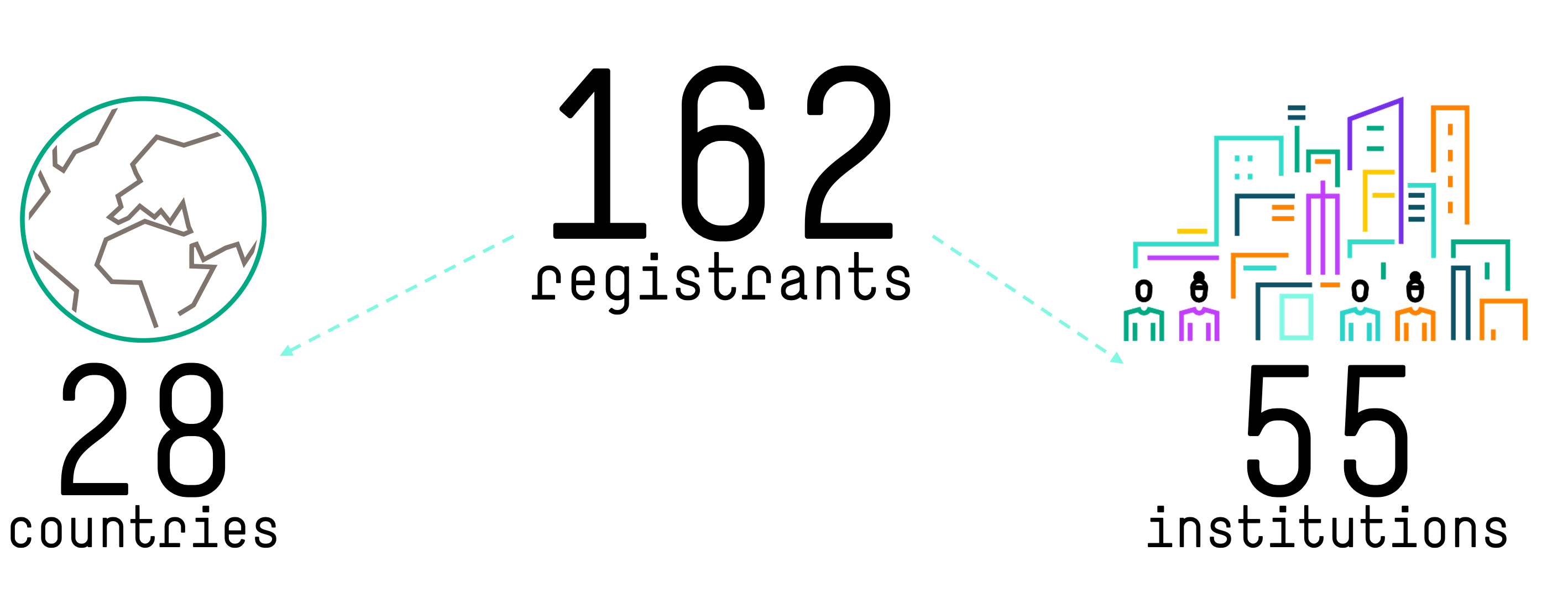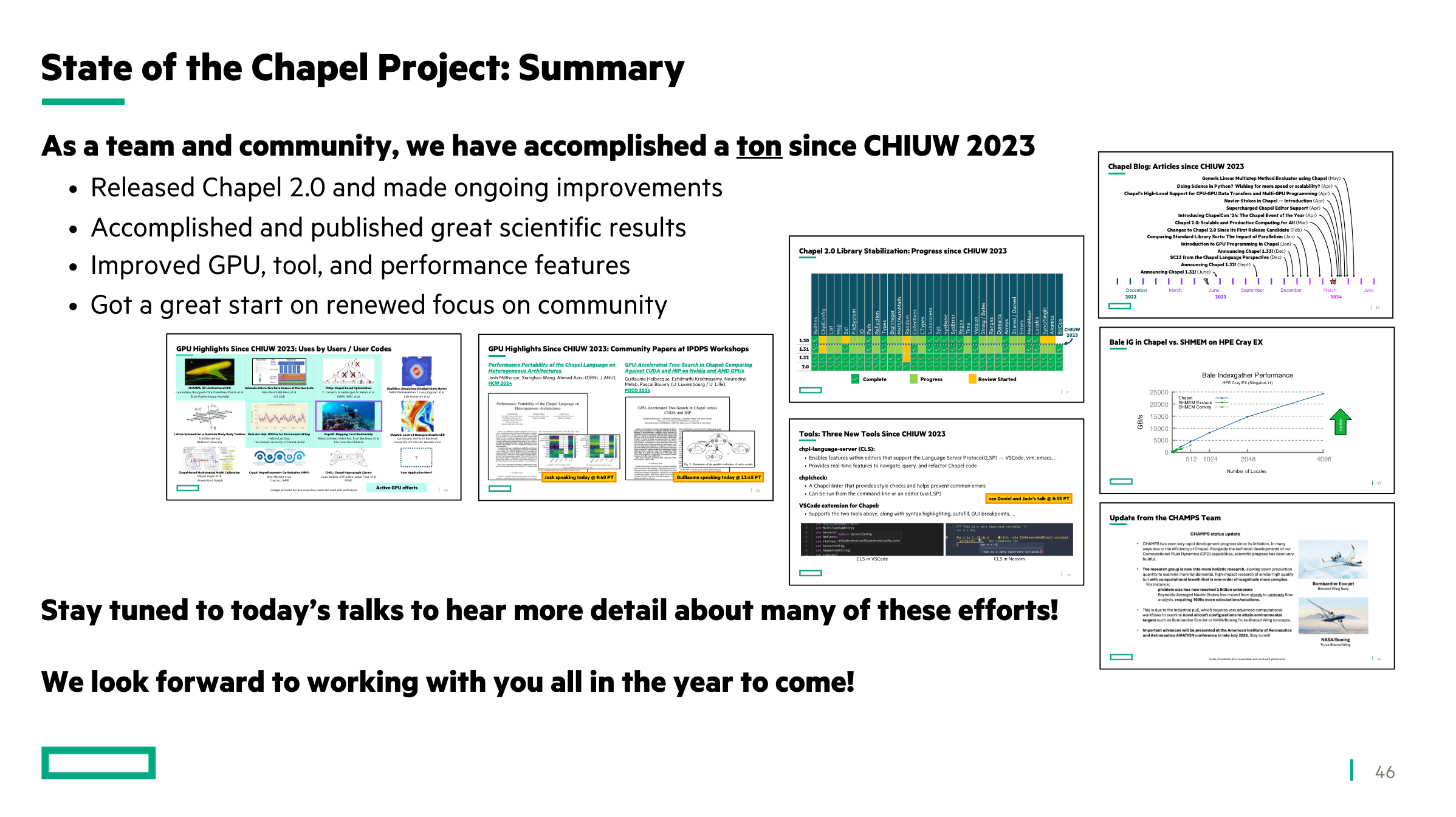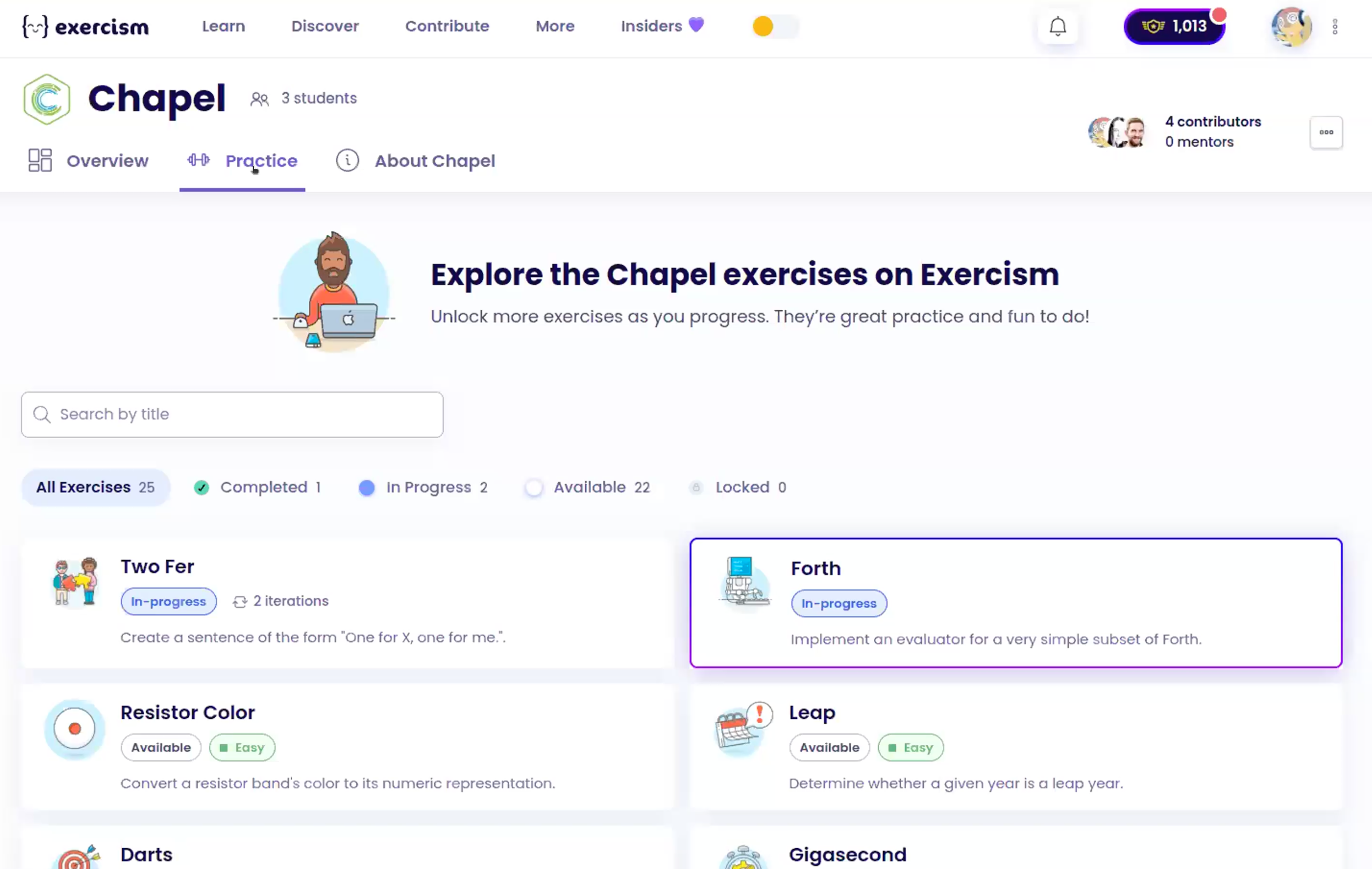The Chapel event of the year, ChapelCon ‘24, has concluded! If you missed it, don’t worry; contents including slides and video recordings of all talks are available on the ChapelCon ‘24 webpage. This year, our main focus in organizing the event was to make it more community-oriented than its predecessor, [note: CHIUW stands for "Chapel Implementers and Users Workshop". If you are curious to learn more about CHIUW, or its rebranding, check out my previous article on ChapelCon. ]. It was amazing to serve as the General Chair of ChapelCon ‘24, especially with the aim of increasing community involvement and participation. That starts with the organization. I would like to thank everyone involved in the ChapelCon organization, spanning 13 institutions across 6 countries. And a special shout out to Josh Milthorpe (ORNL/ANU) for chairing the Program Committee — a first for ChapelCon/CHIUW where the Program Committee was not led by a Chapel team member.
In this article, I will share some big-picture highlights, parts that the participants appreciated, and new ideas for next year’s ChapelCon.
A Keynote for the Ages
Our keynote speaker was Paul Sathre from Virginia Tech. For me, Paul’s keynote, A Case for Parallel-First Languages in a Post-Serial, Accelerated World, was one of the best talks in 11 years of CHIUWs and ChapelCon. Paul discussed the prevalence of parallelism and the shortcomings of traditional programming models that form the basis of de facto parallel programming. His talk was very supportive of thinking about parallelism early in programming education. The ChapelCon audience has made it crystal clear that Paul’s keynote was the highlight of ChapelCon. Here is the word cloud for the answer to the question “Please identify the best parts of ChapelCon ‘24 for you”:

The Word Cloud of the Best Parts of ChapelCon '24 for Attendees
I strongly encourage checking out Paul Sathre’s keynote. The slides and video recording are available alongside the rest of the content from ChapelCon.
Participation in Numbers
One of the big efforts this year was an increased focus on publicity. With the addition of tutorials and structured coding events to the schedule, it was key for us to reach potential Chapel users from all over the world, with different backgrounds, and with different expectations from their programming languages. As a result of these changes, we are excited that we had about 50% more registrants at ChapelCon ‘24 compared to last year’s CHIUW.
Our 162 registrants spanned 28 countries from the Americas to the Middle East, and from Africa to Europe. As the general chair of the event, seeing such diversity among our participants has been a great highlight for me. Our registrants have also listed 55 different affiliations including those from industry, government, and academia.

ChapelCon '24 Reached a More Numerous and Diverse Community Than Ever
Such diversity of backgrounds also underlines another shift in our messaging — Chapel is not a language just for HPC users; Chapel is for everyone who wants to write fast and parallel applications more productively.
Diving into Chapel: Tutorial and Coding Days
As I mentioned, adding tutorials to the agenda was one of the biggest changes this year. Our first Tutorial Day featured a pair of 2-hour tutorials on Chapel and Arkouda. We welcomed 56 different participants throughout the Tutorial Day, who found the day informative. The hands-on parts of the tutorials also featured more modern ways of using Chapel through GitHub Codespaces, and Arkouda through Jupyter notebooks.
The following day was the Coding Day where the demo sessions were the stars of the show. While we had similar events in the past, we expanded this year’s Coding Day significantly with the introduction of an Open Lab session. The Open Lab was the place to be for those who wanted to learn more about Chapel by coding and asking questions along the way. To supplement the more active learning style of the Open Lab, we hosted [note: These demo sessions were highly appreciated by the participants. We have also been asked whether there will be recordings of the sessions. While we did not record those sessions, we are currently planning to start recurring community sessions where Chapel developers will demo different features of the language through live coding, which we will record. Stay tuned on our Blog, Social Media, and Discourse for further details! ], where Chapel developers demonstrated different features of the language (such as GPU support and IO) to the participants. The Open Lab ran alongside Office Hours, where Chapel developers met with users in peer-programming sessions to help with their specific Chapel applications. All in all, on the Coding Day, we interacted with more than 30 Chapel users; new and experienced alike.
Both of these days were an experiment for us, and that experiment was largely successful. Next year, based on suggestions from the attendee survey, we plan to make our tutorials spread out a bit more and cover more areas of the language. Furthermore, we are also considering making tutorials and coding events more intertwined to create an even more engaging schedule and foster a better learning environment.
Expanding our Horizons: Conference Day
The final day of ChapelCon ‘24 was the Conference Day. For the experienced CHIUW audience, this was a familiar setting — invited and submitted talks from the community, with Q&As and community interactions.
Beyond the keynote, the Conference Day featured the traditional State of the Project talk by Brad Chamberlain. Opening the day, Brad summarized highlights from the Chapel community since CHIUW 2023. As a widely-anticipated talk by the community, the State of the Project was called out in several attendee survey responses as one of the best parts of the Conference Day.

The Summary Slide from Brad's State of the Project Talk
Brad’s slides and video recording are also available for those who want to have a 30-minute summary of Chapel highlights from the last year.
The Conference Day would not be what it is if it wasn’t for talks from our community. This year, we had 5 sessions for talks: Tooling, Performance, Outreach, Algorithms, and Chapel in the HPC Ecosystem. Being able to have a program with these categories was another highlight for me. Why?
I view the Performance and Algorithms sessions as representative of fundamentals of Chapel — delivering good performance on a wide variety of hardware across distinct application fields are key goals of Chapel. Let me give a quick summary of the talks in those sessions.
-
The Performance session featured performance studies on sequential execution, multicore CPUs, single GPU, and GPU-based top supercomputers like Frontier and Perlmutter. Seeing such a variety in four talks is a statement for Chapel delivering on its promise to achieve good performance across a wide variety of hardware.
-
The Algorithms session had talks on tree and graph analytics, support for faster imaginary mathematical operations, and a study on using Chapel in meteorological research applications. As a general-purpose programming language, Chapel is already being used in many different types of applications.
What about other sessions? Tooling, outreach, and integration with other technologies are essential for a healthy and mature software project. Seeing a variety of talks from our community in those areas highlights the growing momentum within our community that ignited with Chapel 2.0. Let’s take a quick look at those sessions in more detail:
-
The Tooling session featured talks on a gdb-based Chapel debugger to help with debugging parallel Chapel applications in a familiar setting, and advanced editor support, which can make writing Chapel codes in modern IDEs like VSCode a breeze.
-
The Outreach session had a talk on an Exercism curriculum in Chapel, aiming to provide a medium to learn Chapel as a first programming language. Another talk featured in this section gave a retrospective of an internship with the Chapel team at HPE.

A Snapshot of the Upcoming Chapel Page on Exercism
- Finally, the Chapel in the HPC Ecosystem session. In this session, we had talks on using Chapel in a petabyte-scale, GPU-accelerated database engine, alongside HPX (a C++-based parallel programming library), and finally with Python (have you heard of it? I hear it is pretty cool) for HPC workflows. What a nice variety of fields where Chapel can be used alongside other tools.
I hope you all can see what I see here — a programming language with strong fundamentals spreading its wings. I recommend checking out all the talks to learn more about the varied and amazing work being done by the Chapel community.
Want to Be Involved?
We are already looking forward to the next ChapelCon. One of the key points for us will be to digest the survey results from this year again to make sure we target areas of improvement noted by our attendees as a way to make ChapelCon even more welcoming, from those who don’t know Chapel at all, to those who have been around for a while.
We want to increase our community’s participation in planning as well. Organizing events such as ChapelCon constitutes many small decisions and associated work. The more diverse voices we have in such decisions and the work, the better ChapelCons we will have. While we don’t have anything concrete for that at the moment, that is kind of the point — we want to call for volunteers to take part in the discussions and the organizational work. So, let this also serve as an early call: if you are interested in helping organize the next ChapelCons, please reach out!
